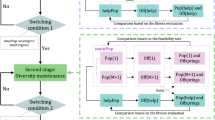Abstract
For the low optimization precision and long optimization time of genetic algorithm, this paper proposed a multi-population agent co-genetic algorithm with chain-like agent structure (MPAGA). This algorithm adopted multi-population parallel searching mode, close chain-like agent structure, cycle chain-like agent structure, dynamic neighborhood competition and orthogonal crossover strategy to realize parallel optimization, and has the characteristics of high optimization precision and short optimization time. In order to verify the optimization precision of this algorithm, some popular benchmark test functions were used for comparing this algorithm and a popular agent genetic algorithm (MAGA). The experimental results show that MPAGA has higher optimization precision and shorter optimization time than MAGA.
Similar content being viewed by others
References
Goldberg DE (1989) Genetic algorithms in search optimization & machine learning. Addison-Wesley, Reading
Holland JH (1992) Adaptation in nature and artificial system. MIT Press, Cambridge
Michalewicz Z, Fogel DB (2000) How to solve it: modern heuristics. Springer, Berlin, pp. 83–234
Potvin J, Dube D, Robillard C (1966) Hybrid approach to vehicle routing using neural networks and genetic algorithm. Appl Intell 6(3), 241–252
Srinivas M, Patnaik LM (1994) Adaptive probabilities of crossover and mutation in genetic algorithms. IEEE Trans Syst Man Cybern Part B 24(4), 656–667
Gong D-W, Sun X-Y, Guo X-J (2002) Novel survival of the fittest genetic algorithm. Control Decis 17(6), 908–911
Zhong W, Liu J, Xue M, Jiao L (2004) A multi-agent genetic algorithm for global numerical optimization. IEEE Trans Syst Man Cybern Part B 34(2), 1128–1141
Zeng X-P, Li Y-M, Qin J A dynamic chain-like agent genetic algorithm for global numerical optimization and feature selection, Neurocomputing. Available online at www.sciencedirect.com
Olsson B (2001) Co-evolutionary search in asymmetric spaces. Inf Sci 133(3–4), 103–125
Potter MA, De Jong KA (2000) Cooperative coevolution: an architecture for evolving coadapted subcomponents. IEEE Trans Evol Comput 8(1), 1–29
Gao Y, Xie S-L, Xu R-N, Li Z-H (2006) A multi sub-population particle swarm optimizer based on clustering. Appl Res Comput 23(4), 40–41
Su C-H, Hou T-H (2008) Using multi-population intelligent genetic algorithm to find the Pareto-optimal parameters for a nano-particle milling process. Expert Syst Appl 34(4), 2502–2510
Leung YW, Wang Y (2001) An orthogonal genetic algorithm with quantization for global numerical optimization. IEEE Trans Evol Comput 5(2), 41–53
Pan ZJ, Kang LS (1997) An adaptive evolutionary algorithms for numerical optimization. In: X Yao, JH Kim, T Furuhashi (eds.) Simulated evolution and learning. Lecture notes in artificial intelligence. Springer, Berlin, pp 27–34
Yao X, Liu Y, Lin G (1999) Evolutionary programming made faster. IEEE Trans Evol Comput 3(7), 82–102
Wolpert DH, Macready WG (1997) No free lunch theorems for optimization. IEEE Trans Evol Comput 1(1), 67–82
Whitley D (1999) A Free Lunch proof for gray versus binary encodings. In: W Banzhaf, J Daida, AE Eiben, MH Garzon, V Honavar, M Jakiela, RE Smith (eds.), Proceedings of the genetic and evolutionary computation conference (GECCO’99), Orlando, FL, vol 1. Morgan Kaufmann, San Francisco, pp 726–733
Kimbrough SO, Koehler GJ, Lu M, Wood DH On a Feasible–Infeasible Two-Population (FI-2Pop) genetic algorithm for constrained optimization: Distance tracing and no free lunch. European J Oper Res. Available online at www.sciencedirect.com
Schumacher C, Vose MD, Whitley LD (2001) The No Free Lunch and description length. In: L Spector, E Goodman, A Wu, W Langdon, H-M Voigt, M Gen, S Sen, M Dorigo, S Pezeshk, M Garzon, E Burke (eds.), Proceedings of the genetic and evolutionary computation conference (GECCO 2001), San Francisco, CA. Morgan Kaufmann, San Francisco, pp 565–570
Tu ZG, Lu Y (2004) A robust stochastic genetic algorithms (StGA) for global numerical optimization. IEEE Trans Evol Comput 8(5), 456–470
Koehler GJ (2007) Conditions that obviate the no free lunch theorems for optimization. Inf J Comput 19(2), 273–279
Igel C, Toussaint M (2003) On classes of functions for which no free lunch results hold. Inf Process Lett 86(6), 317–321
Deb K, Pratap A, Agarwal S, Meyarivan TA (2002) A fast and elitist multi-objective genetic algorithm: NSGA-II. IEEE Trans Evol Comput 6(2), 182–197
Mitchell M (1996) An introduction to genetic algorithms. MIT Press, Cambridge, pp 155–181
Author information
Authors and Affiliations
Corresponding author
Rights and permissions
About this article
Cite this article
Li, Y., Zeng, X. Multi-population co-genetic algorithm with double chain-like agents structure for parallel global numerical optimization. Appl Intell 32, 292–310 (2010). https://doi.org/10.1007/s10489-008-0146-7
Received:
Accepted:
Published:
Issue Date:
DOI: https://doi.org/10.1007/s10489-008-0146-7




